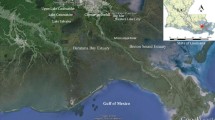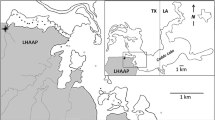Abstract
Surface sediment quality was assessed during a 35-day artificial flood in a shallow (<1.5 m) oxbow lake along the Coldwater River, Mississippi, using Hyalella azteca 28-day bioassays. Seventeen pesticides were monitored in sediments before, during and after flooding, with increases in atrazine and metolachlor concentrations coinciding with two unexpected storm events, 51 and 56 mm, during and after flooding, respectively. Mean 28-day H. azteca survival was >85% throughout this study. However, growth was affected at three sites during flooding with limited growth recovery after flooding. Patterns in observed growth impairment were associated with changes in atrazine (R 2 = 0.524) and fipronil sulfone (R 2 = 0.584) concentrations.
Similar content being viewed by others
References
American Public Health Association(APHA) (1998) Standard methods for the examintaion of water and wastewater, 20th edn. American Public Health Association, Washington, DC
Anderson TD, Lydy MJ (2002) Increased toxicity to invertebrates associated with a mixture of atrazine and organophosphate insecticides. Environ Toxicol Chem 21:1507–1514. doi:10.1897/1551-5028(2002)021<1507:ITTIAW>2.0.CO;2
Bennett ER, Moore MT, Cooper CM, Smith S (2000) Method for the simultaneous extraction and analysis of two current use pesticides, atrazine and lambda-cyhalothrin, in sediment and aquatic plants. Bull Environ Contam Toxicol 64:825–833. doi:10.1007/s001280000077
Brookes A, Shields FD (1996) River channel restoration; guiding principles for sustainable projects. Wiley, New York
Buijse AD, Coops H, Startas M, Jans LH, Van Geest GJ, Grifts RE, Ibelings BW, Oosterberg W, Roozen FCJM (2002) Restoration strategies for river floodplains along large lowland rivers in Europe. Freshw Biol 47:889–907. doi:10.1046/j.1365-2427.2002.00915.x
Cooper CM, Knight SS (1991) Nutrient and sediment trapping efficiency in small farm ponds. Proceedings environmentally sound agriculture 2:673–680
Cooper C, Smith S, Moore M (2003) Surface water, ground water and sediment quality in three oxbow lake watersheds in the Mississippi Delta agricultural region: pesticides. Int J Ecol Envion Sci 29:171–184
de March BGE (1981) Hyalella azteca (Saussure). In: Lawrence SG (ed) Manual for the culture of selected freshwater invertebrates. Canadian Spec Publ Fish Aquat Sci 54:61–77
Deaver E, Rodgers JH Jr (1996) Measuring bioavailable copper using anodic stripping voltammetry. Environ Toxicol Chem 15:1925–1930. doi:10.1897/1551-5028(1996)015<1925:MBCUAS>2.3.CO;2
Dodds WK (2002) Freshwater ecology: concepts and environmental applications. Academic Press, New York
Gore JA, Shields FD (1995) Can large rivers be restored? Bioscience 45:142–152. doi:10.2307/1312553
Moore MT, Lizotte RE, Cooper CM, Smith S, Knight SS (2004) Survival and growth of Hyalella azteca exposed to three Mississippi oxbow lake sediments. Bull Environ Contam Toxicol 72:777–783. doi:10.1007/s00128-004-0312-5
Moore MT, Lizotte RE, Knight SS, Smith S, Cooper CM (2007) Assessment of pesticide contamination in three Mississippi Delta oxbow lakes using Hyalella azteca. Chemosphere 67:2184–2191. doi:10.1016/j.chemosphere.2006.12.026
Nebeker AV, Cairns MA, Gakstatter JH, Malueg KW, Schuytema GS, Krawczyk DF (1984) Biological methods for determining toxicity of contaminated freshwater sediments to invertebrates. Environ Toxicol Chem 3:617–630. doi:10.1897/1552-8618(1984)3[617:BMFDTO]2.0.CO;2
Schlenk D, Huggett DB, Allgood J, Bennett E, Rimoldi J, Beeler AB, Block D, Holder AW, Hovinga R, Bedient P (2001) Toxicity of fipronil and its degredation products to Procambarus sp.: field and laboratory studies. Arch Environ Contam Toxicol 41:325–332. doi:10.1007/s002440010255
Schulz R (2001) Rainfall-induced sediment and pesticide input from orchards into the Lourens River, Western Cape, South Africa: importance of a single event. Wat Res 35:1869–1876. doi:10.1016/S0043-1354(00)00458-9
Schulz R, Liess M (1999) A field study of the effects of agriculturally derived insecticide input on stream macroinvertebrate dynamics. Aquat Toxicol 46:155–176. doi:10.1016/S0166-445X(99)00002-8
Shields FD, Smiley PC, Cooper CM (2002) Design and management of edge-of-field water control structures for ecological benefits. J Soil Water Conserv 57:151–157
Statistical Package for the Social Sciences (SPSS), Inc. (1997) SigmaStat for Windows version 2.03
Trimble AJ, Lydy MJ (2006) Effects of triazine herbicides on organophosphate insecticide toxicity in Hyalella azteca. Arch Environ Contam Toxicol 51:29–34. doi:10.1007/s00244-005-0176-7
US Environmental Protection Agency (USEPA) (1994) Methods for measuring the toxicity and bioaccumulation of sediment-associated contaminants with freshwater invertebrates. EPA 600/R–94/024
Wan MT, Buday C, Schroeder G, Kuo J, Pasternak J (2006) Toxicity to Daphnia magna, Hyalella azteca, Oncorhynchus kisutch, Oncorhynchus mykiss, Oncorhynchus tshawytscha, and Rana catesbeiana of atrazine, metolachlor, simazine, and their formulated products. Bull Environ Contam Toxicol 76:52–58. doi:10.1007/s00128-005-0888-4
Willis GH, McDowell LL (1982) Review: pesticides in agricultural runoff and their effects on downstream water quality. Environ Toxicol Chem 1:267–279. doi:10.1897/1552-8618(1982)1[267:RPIARA]2.0.CO;2
Acknowledgments
Appreciation is extended to C. Bryant, L. Brooks, and D. McChesney for sample collection and analytical assistance as well as Peter C. Smiley, Fred Rhoton and Luther A. Knight, Jr. for reviewing an earlier version of the manuscript. Mention of equipment, software or a pesticide does not constitute an endorsement for use by the US Department of Agriculture nor does it imply pesticide registration under FIFRA as amended. All programs and services of the USDA are offered on a nondiscriminatory basis without regard to race, color, national origin, religion, sex, marital status, or handicap.
Author information
Authors and Affiliations
Corresponding author
Rights and permissions
About this article
Cite this article
Knight, S.S., Lizotte, R.E., Moore, M.T. et al. Mississippi Oxbow Lake Sediment Quality During an Artificial Flood. Bull Environ Contam Toxicol 82, 496–500 (2009). https://doi.org/10.1007/s00128-009-9653-4
Received:
Accepted:
Published:
Issue Date:
DOI: https://doi.org/10.1007/s00128-009-9653-4




